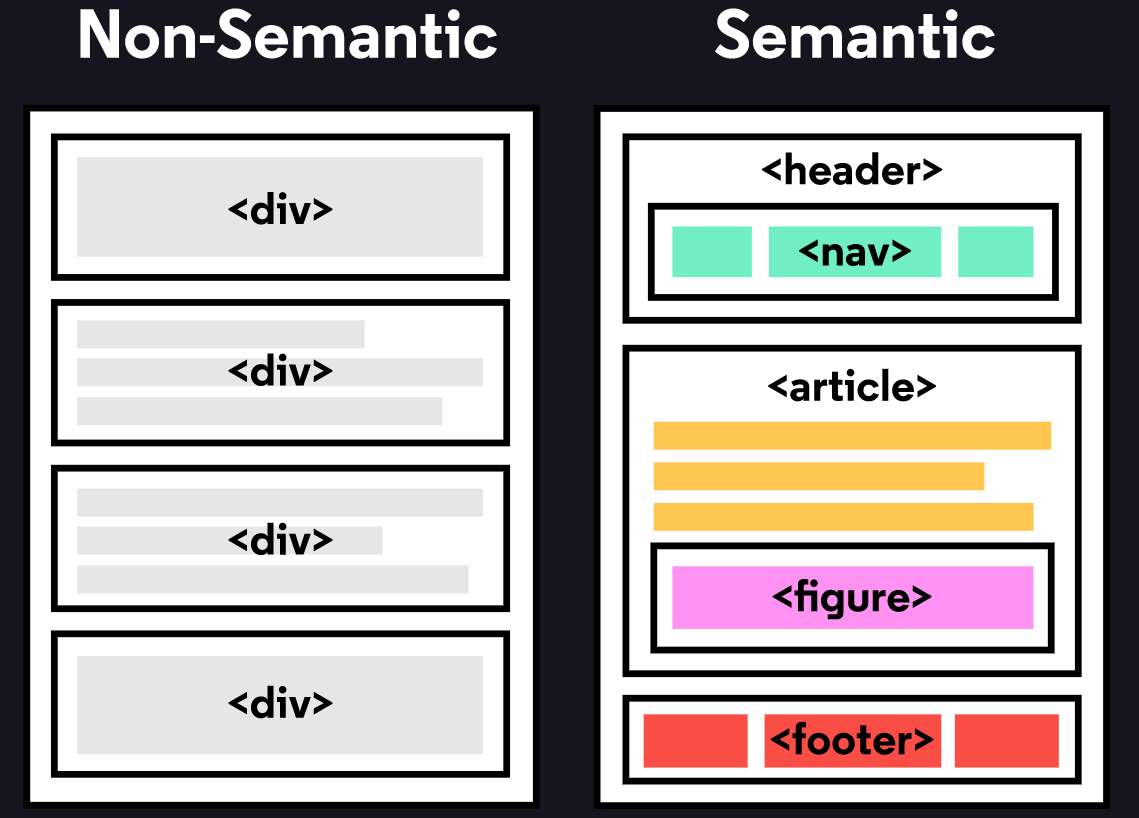Semantic ("relation to meaning") elements provide information about the content between the opening and closing tags.
➙ Elements such as <div> and <span> are not semantic elements since they provide no context as to what is inside of those tags.

Why use Semantic HTML?
✔️Accessibility: Semantic HTML makes webpages accessible for mobile devices and for people with disabilities as well. This is because screen readers and browsers are able to interpret the code better.
✔️SEO: It improves the website SEO, or Search Engine Optimization, which is the process of increasing the number of people that visit your webpage. With better SEO, search engines are better able to identify the content of your website and weight the most important content appropriately.
✔️Easy to Understand: Semantic HTML also makes the website’s source code easier to read for other web developers.
Element Placement
Semantic HTML introduces elements that can tell developers exactly what the element does or where it’s placed based on the name of that element. Some of these elements are <header>, <nav>, <main>, and <footer>.
<header>describes the content at the top of the page<body>. It may include a logo, navigational links or a search bar.<nav>encapsulates the page’s navigational links. It is often placed inside the<header>or<footer>.<main>encapsulates the main content of a page between the header/navigation and the footer areas.<footer>includes the page’s footer content at the bottom of the<body>.
Embedding media
Semantic HTML introduces us to <video>, <audio> and <embed>.
<video>allows us to add videos to our website.<audio>allows us to implement audio into our website.<embed>can be used to implement any type of media. These elements are universal in that they all use the src attribute to link the source of the content.<video>and<audio>requires a closing tag while<embed>is a self-closing tag.
<!--Video Tag-->
<video src="4kvideo.mp4">video not supported</video>
<!--Audio Tag-->
<audio src="koreanhiphop.mp3"></audio>
<!--Embed tag-->
<embed src="babyyoda.gif"/><figure> and <figcaption>
The <figure> element is used to encapsulate media such as an image, diagram. or code snippet. The <figcaption> element is used to describe the media encapsulated within the <figure> element.
- Developers will normally use
<figcaption>within the<figure>element to group the media and description. This way, if a developer decides to change the position of the media, the description will follow along with it.
<figure>
<img src="qwerty.jpg">
<figcaption>The image shows the layout of a qwerty keyboard.</figcaption>
</figure><section> and <article>
<section> defines elements in a document, such as chapters, headings, or any other area of the document with the same theme. <article> holds content that makes sense on its own such as articles, blogs, and comments.
- Generally developers will use
<section>to define a theme for the webpage and use<article>to write independent content for that theme. This does not mean that<article>has to be used with<section>.
<section>
<!--defines theme-->
<h2>Top Sports league in America</h2>
<!--writes independent content relating to that theme-->
<article>
<p>One of the top sports league is the nba.</p>
</article>
</section><aside> Aside Element
The <aside> element is used to mark additional information that can enhance another element but isn’t required in order to understand the main content. Usually, this information would be in a sidebar or a location where it doesn’t obstruct the main piece of content. An example of this would be an article that discusses how to take care of a dog and next to the article an ad would appear advertising a dog grooming product.
<article>
<!--Main Content-->
</article>
<aside>
<!--Additional information-->
</aside>
NFTs provide a way to verify the authenticity and ownership of digital art. This has been particularly important in combating issues like art theft and forgery in the digital space. Online non Gamstop casinos